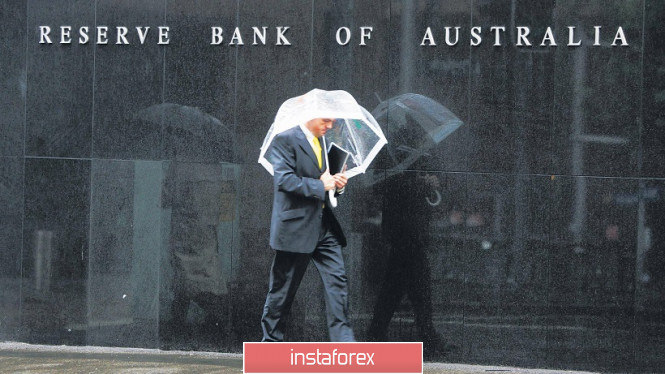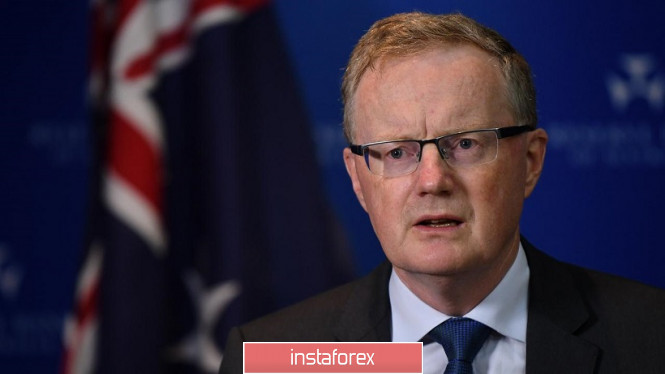
The RBA meeting was held today. They lowered the interest rate to 0.1% and announced buying five and ten-year government bonds in the amount of $100 billion over the next 6 months. This decision was already expected, so the bears failed to impulsively break through the support level of 0.7000. However, the tone of the accompanying statement, as well as the contradictory rhetoric of the RBA head, Philip Lowe, did not allow the buyers of the AUD/USD pair to take control. As a result, the pair is still under background pressure.
The results of the RBA's November meeting were very pessimistic. The Central Bank did not actually rule out further easing of monetary policy, although it did not directly announce the corresponding steps. However, many economists at major banks agreed that the RBA left a space for subsequent movements. At the same time, there is talk in the market that a rate cut to zero is only a matter of time, especially if the labor market does not show steady growth in the coming months. Some experts, such as Stephen Koukoulas (former economic adviser to the Australian Prime Minister and former chief economist at Citibank), are equally confident that the Central Bank will go into the negative area within a year – first to the level of -0.1%, and then to -0.4%. But, fortunately, this opinion is not yet prevailing among experts.

At the same time, the RBA members were really worried about the latest trends in the labor market, so this issue has been in focus. It should be recalled that this concern is justified, since the growth rate in the number of employees in October reflected alarming trends. First, this indicator declined for the first time since May of this year (when the country was just coming out of full lockdown mode). Second, this decline was mainly due to a reduction in the full employment component. If the indicator of partial employment growth decreased by 9 thousand, the indicator of full employment moved into the negative zone by 20 thousand.
In view of this, Philip Lowe reiterated during his press conference today that such an imbalance would negatively affect the recovery process. After all, full-time positions imply a higher level of wages and a higher level of social security, compared with temporary part-time jobs; hence, the decline in Australian's consumer activity and weak inflationary growth. Therefore, the current dynamics seriously worried the members of the Australian regulator. In an accompanying statement, they said that in order to achieve the inflation target, the rate of earnings growth must be significantly higher than the current one. As for unemployment, the Central Bank says that will remain at high levels, but it will reach the peak when approaching the 8% level.
Despite RBA's dovish meeting, we should highlight the following: First, the Central Bank is ready for further steps to ease monetary policy, if necessary. Although they have not announced any clear criteria in this context, it should be clear that traders should focus on the dynamics of the labor market and inflation. Secondly, the RBA members assured the market that the interest rate will not be increased for at least the next three years. They also mentioned that the size and duration of the incentive program may be revised. In connection with this, some experts have stated that the 6-month QE period will almost certainly be extended. In addition, they stated that they are ready to buy bonds in any necessary amount to reach the target level of 3-year bond yields. Moreover, these purchases will be as a bonus, that is, an addition to the above-mentioned 100-billion-dollar asset purchase program.
It is also noteworthy that the accompanying statement also contains the phrase that "the measures taken by the Central Bank will put downward pressure on the Australian dollar." However, the expectations of the Reserve Bank did not coincide with reality. The AUD slightly declined after this meeting, but did not weaken its position. Thus, it is holding out above the key support level of 0.7000. Meanwhile, the AUD/USD bears were counting on a sharp downward breakdown, which would help them consolidate within the 69th figure.

Unfortunately, this did not happen. The AUD/USD pair left the mid-70th figure area after a relatively small and short-term downward impulse. This is partly because the US dollar index is showing a downward trend today, after another upward surge yesterday. However, the main problem of the AUD/USD bears is that the RBA did not implement the worst-case scenario that was discussed before the meeting. So, according to some analysts, the Central Bank could reduce the rate to zero and announce further steps in this direction, thereby hinting at a negative zone. The minutes of the RBA's October meeting generally allowed for this scenario. However, this option was not implemented, so the Australian dollar remained above and withstood the blow from the Central Bank.
The further behavior of the AUD/USD pair in the medium-term will depend solely on the behavior of the US currency, which in turn will respond to the election results and to the first statements of the main rivals. In general, long positions can be considered from the level of 0.7000. We saw that this support level was too tough for the pair's bears, even despite dollar's strengthening yesterday and the dovish results of the November RBA meeting. This suggests that the pair will attract buyers, when approaching the support level and moving to the 69th figure in the short-term. The first target of the corrective growth is 0.7120, which is the middle line of the Bollinger Bands indicator on the daily chart, coinciding with the Kijun-sen line.